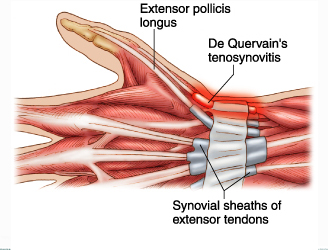
Tenosynovitis
Your physiotherapist is the best person to individually advise you how to treat your de Quervain’s tenosynovitis. They can utilise various local modality and soft tissue treatment options to assist your recovery. Until you are assessed, please try the following.
If at all possible, you must change or stop all activities that cause your symptoms. Take frequent breaks when doing repeated hand and thumb actions. Avoid repetitive hand motions, such as heavy grasping, wringing, or turning and twisting movements of the wrist. Keep the wrist in a neutral alignment. In other words, keep it in a straight line with your arm, without bending it forward or backward.
Your physiotherapist or doctor may want you to wear a special forearm and thumb splint called a thumb-spica splint. This splint keeps the wrist and lower joints of the thumb from moving. The splint allows the APL and EPB tendons to rest, giving them a chance to begin to heal.
WE TREAT FOR
- Osteo Arthritis (Knee Pain)
- Peri Arthritis (Shoulder Pain)
- Rheumatoid Arthritis
- Spondylitis (Neck Pain)
- Sciatica (Back Pain)
- Fracture Rehabilitation
- Muscle & Joint Pains
- Spinal Disc Problems
- Hemiplegia (Paralysis)
- Paraplegia
- Quadriplegia
- G.B. Syndrome
- Brachial Plexus Injury
- Wrist drop & Foot drop
- Club Foot
- Ligament Injuries
- Tennis elbow
- Golfers Elbow
- Toritcollis
- Plantar Fasciitis (Heel Pain)
- Hip & Knee replacement Rehabilitation
- Ankylosing Spondylitis
- Bells Palsy
- Brusitis
- Achilles Tendonitis
- Carpal Tunnel Syndrome
- Piriformis Syndrome
- Tenosynovitis
- Fibromyalgia
- Prenatal & Post Natal Training
- Cupping Therapy
- Unweighing System
- Latest Laser therapy Equipment
- TENS
- Spinal Traction
- Continuous Passive Movement(C.P.M)
- Interferential Therapy(IFT)
- Hydrocollator Therapy
- Ultra Sound Therapy
- Muscle Stimulator